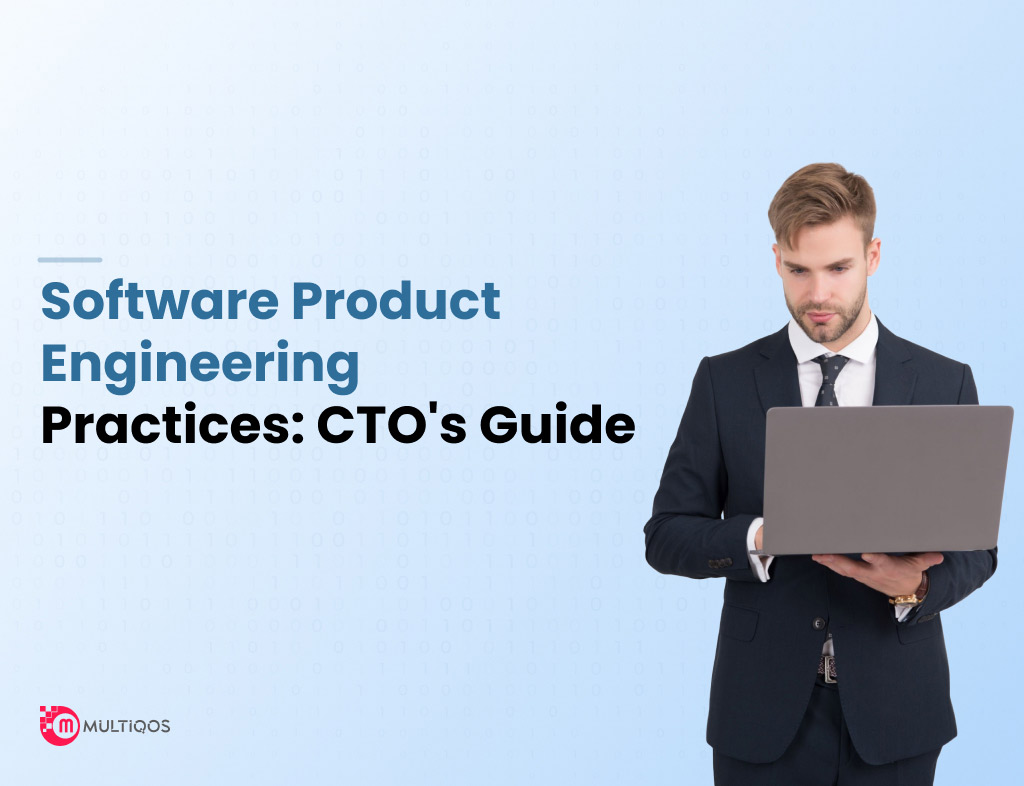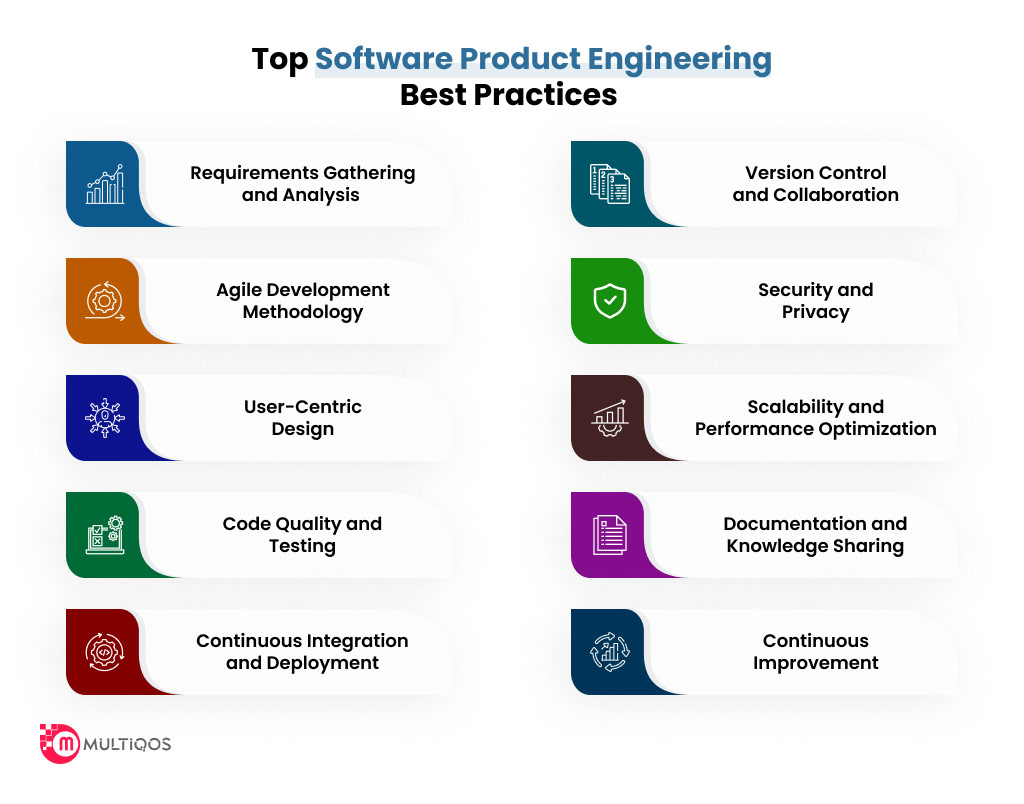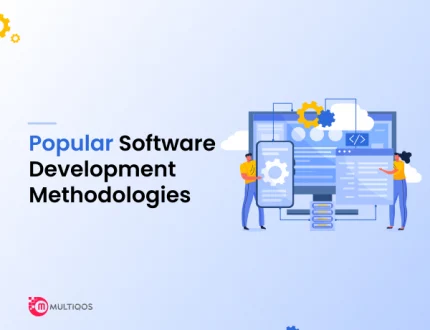Software Product Engineering Practices Every CTO Needs to Implement

CTOs are responsible for monitoring the latest trends in software product engineering and adopting dependable and effective software engineering methods. This involves establishing and managing systems that fulfil the precise requirements of users. Prioritizing practices that are affordable to create and maintain is crucial.
The software development process encompasses various concepts, principles, techniques, and tools that engineers utilize on a regular basis. These resources enable CTOs to efficiently oversee multiple software projects and strive to turn concepts into tangible outcomes. The following are seven software product engineering practices that should be integrated into the software product engineering process by every CTO.
Importance of Software Product Engineering Best Practices
Software product engineering best practices are vital for ensuring the success and efficiency of software development projects. Here are some key reasons why these practices hold significance:
-
Ensuring Consistency and Quality:
Best practices establish a standardized framework for software development, guaranteeing consistent and high-quality outcomes. They offer policies and procedures that support readability, maintainability, and reuse of code, resulting in more dependable and durable software.
-
Streamlining the Development Process:
By following best practices, the development process becomes more streamlined through guidelines on project management, version control, testing, and documentation. As a result, team members work more collaboratively, make fewer mistakes, and spend less time and money developing new products.
-
Promoting Scalability and Maintainability:
Best practices prioritize modular and scalable software design, facilitating the addition of new features and accommodating future changes. Following these guidelines minimizes the chance of software obsolescence and prevents technical debt. It also makes maintenance, extension, and upgrades simple over time.
-
Enhancing Security and Reliability:
Best practices incorporate security considerations throughout the app development lifecycle, aiding in identifying and mitigating vulnerabilities. By following secure coding practices, conducting regular security audits, and implementing robust testing methodologies, software products become more resilient against cyber threats, ensuring data protection and earning user trust.
-
Focusing on User Satisfaction:
Best practices concentrate on understanding, meeting user needs, and enhancing user experiences. Software products can deliver intuitive interfaces, optimal performance, and features that align with user expectations by incorporating usability testing, gathering user feedback, and implementing continuous improvement cycles.
-
Addressing Compliance and Legal Requirements:
Best practices also address compliance and legal considerations, ensuring that software products meet industry standards and regulatory requirements. This helps organizations avoid legal consequences, maintain data privacy, and protect intellectual property rights.
-
Gaining Competitive Advantage:
Adhering to software product engineering best practices gives organizations a competitive edge. Businesses may get and keep more consumers by providing high-quality, secure, and user-centric software solutions, setting themselves apart from rivals in the market.
Essential Best Practices for Software Product Engineering
Here are some essential best practices for software product engineering:
-
Requirements Gathering and Analysis:
Thoroughly comprehending and documenting user requirements is vital for successful software development. This entails actively involving stakeholders, conducting interviews, and utilizing techniques like user stories and use cases to capture and analyze requirements accurately.
-
Agile Development Methodology:
Agile methodologies, such as Scrum or Kanban, encourage iterative development, collaboration, and flexibility. They involve breaking down projects into smaller tasks, setting short-term goals, and regularly reviewing and adapting the development process based on feedback.
-
Continuous Integration and Deployment:
CI/CD practices automate building, testing, and deployment processes. Organizations can achieve faster feedback loops, reduce errors, and deliver software more reliably by continuously integrating code changes, running automated tests, and frequently deploying to production.
-
Quality Assurance and Testing:
Conducting code reviews by peers helps identify bugs, improve code readability, and enforce best practices. Quality assurance techniques like static code analysis, unit testing, and automated testing frameworks ensure software quality and reliability.
-
Scalability and Performance Optimization:
Effectively utilizing version control systems, such as Git, enables teams to collaborate, track code changes, and manage different software versions. Branching and merging strategies facilitate parallel development and ensure code stability.
-
Security and Data Privacy Measures:
Integrating security practices throughout the development lifecycle is vital to protect software from vulnerabilities. This includes secure coding practices, vulnerability assessments, penetration testing, and staying updated with security patches and updates.
-
User-Centric Design and User Experience (UX):
Placing users at the center of software development involves understanding their needs, preferences, and pain points. User input and usability testing aid in validating design choices, enhancing the user experience, and fostering ongoing development.
-
Maintenance and Support Strategies:
Monitoring software performance, user behavior, and feedback allows organizations to identify issues, optimize performance, and make data-driven improvements. Implementing analytics tools, error monitoring systems, and user feedback mechanisms enables continuous monitoring and feedback loops.
By following these best practices, organizations may improve the effectiveness, quality, and user happiness of their software product engineering initiatives. To satisfy each project and organization’s unique requirements and limitations, it’s crucial to modify and personalize these methods.
Benefits of Implementing Software Product Engineering Best Practices
Implementing best practices in software product engineering offers digital transformation to organizations. Here are some key benefits:
-
Increased Efficiency:
By adhering to standardized guidelines and processes, teams can collaborate effectively, eliminate redundant tasks, and reduce delays, leading to faster development cycles.
- Enhanced Quality:
By incorporating techniques such as code reviews, testing methodologies, and documentation standards, organizations can minimize defects, enhance code readability, and deliver software products of higher quality and reliability.
-
Cost Savings:
By minimizing rework, identifying and resolving issues early in the development process, and improving overall efficiency, organizations can reduce project costs and optimize resource allocation.
-
Improved Collaboration:
By leveraging tools for version control, project management, and knowledge sharing, organizations can foster effective collaboration, leading to better coordination, knowledge transfer, and a shared understanding of project goals.
-
Faster Time to Market:
By adopting agile web development methodologies, automating processes, and integrating continuous integration and deployment practices, organizations can accelerate development cycles and respond promptly to changing market demands
-
Scalability and Flexibility:
Organizations may quickly expand their software products and adapt to changing business demands by following architectural principles, using flexible development techniques, and utilizing cloud-based technology.
-
Risk Mitigation:
By integrating security practices throughout the development process, conducting regular assessments, and following compliance guidelines, organizations can mitigate risks, safeguard data, and ensure legal compliance.
-
Enhanced Customer Satisfaction:
By understanding user needs, incorporating feedback, and delivering intuitive and user-friendly software products, organizations can enhance the overall user experience and foster customer loyalty.
-
Competitive Advantage:
Organizations may stand out, get more clients, and develop a reputation for excellence by regularly producing high-quality, dependable, and innovative software solutions.
-
Continuous Improvement:
By regularly evaluating processes, gathering feedback, and making iterative enhancements, organizations can optimize their software development practices, stay ahead of competitors, and adapt to industry trends.
However, implementing software product engineering best practices can pose several challenges. Let us have a look at them…
Also Read: Top Flutter App Development Firms 2024
Challenges in Implementing Software Product Engineering Best Practices
According to experienced software development companies, here are some common obstacles organizations may encounter:
-
Change Resistance:
Introducing new practices and processes may face resistance from team members accustomed to existing workflows.
-
Limited Awareness and Training:
If team members are unaware of the benefits or lack the necessary skills to implement the practices effectively, it can hinder their adoption and effectiveness.
-
Time and Resource Constraints:
Organizations may struggle with allocating dedicated resources and providing sufficient time for training, process improvements, and adopting new tools and technologies.
-
Legacy Systems and Technical Debt:
Outdated technologies and inefficient codebases may require substantial refactoring or redevelopment to align with the desired practices, causing delays and additional complexity.
-
Scalability and Integration:
Scaling best practices across teams and projects can be challenging, particularly in larger organizations with diverse software development teams.
-
Balancing with Project Constraints:
Striking a balance between adhering to best practices and meeting project timelines, budget limitations, or unique client needs can be a delicate challenge.
-
Monitoring and Continuous Improvement:
Organizations must establish mechanisms to assess the effectiveness of the practices, gather feedback, and make necessary adjustments to optimize their impact.
-
Organizational Culture and Leadership Support:
If the culture does not prioritize or support adopting these practices, it can hinder progress and create resistance within the organization.
Wrapping Up!
To thrive and expand, every software product-based business must prioritize implementing software product engineering practices. CTOs play a vital role in ensuring the adoption of these practices to meet customer needs and exceed their expectations.
By implementing these practices, businesses can effectively minimize technical debt, enhance customer satisfaction, retain their customer base, and foster increased customer loyalty. You can hire a software development company in India for complete assistance implementing best practices.
Get ready for custom software development for your business!
We offer scalable custom software development solutions that meet your business needs.
FAQ on Software Product Engineering Practices
A Chief Technology Officer (CTO) manages a company’s research and development (R&D) projects and takes care of its technology needs. Staying abreast of emerging and current technologies is essential for a CTO to fulfil its role effectively.
By establishing a complete strategy that includes effective communication, offering training and education, involving stakeholders, assigning the right resources, and exhibiting a commitment to continual development, organizations may overcome problems.
Organizations can customize software product engineering best practices by considering factors such as project requirements, budget constraints, timelines, unique client needs, organizational culture, and available resources.
Get In Touch





